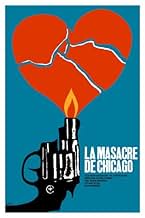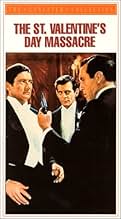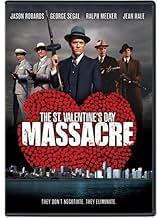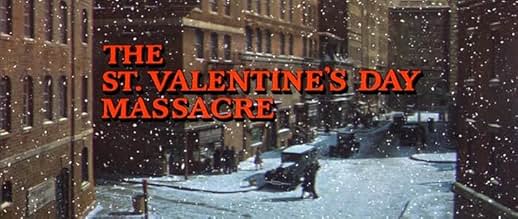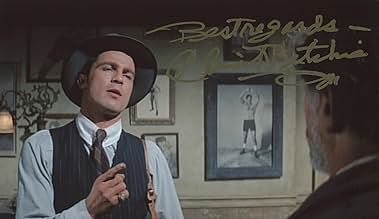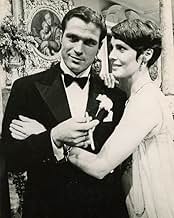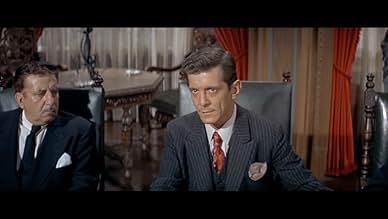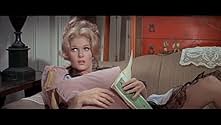AVALIAÇÃO DA IMDb
6,6/10
5,1 mil
SUA AVALIAÇÃO
Surpresa no Dia dos Namorados de Al Capone para a gangue rival Bugs Moran em Chicago em 1929.Surpresa no Dia dos Namorados de Al Capone para a gangue rival Bugs Moran em Chicago em 1929.Surpresa no Dia dos Namorados de Al Capone para a gangue rival Bugs Moran em Chicago em 1929.
Joe Turkel
- Jake 'Greasy Thumb' Guzik
- (as Joseph Turkel)
Avaliações em destaque
Why is it that people quibble about Jason Robards not looking like Capone? Many actors who have played him, from F. Murray Abraham to William Forsythe, really didn't resemble him. Maybe it's because this film attempts a semi-documentary approach. Perhaps it's the most accurate Hollywood drama on Capone, but the other semi-documentaries of the time (such as Fox's own THE LONGEST DAY), had the look and lighting that reminded a viewer of a documentary, while this one doesn't. In fact, its style is more evocative of a 1930's Warner Bros. gangster film. Even George Segal's bullying the bartender and his mashing his girlfriend's face with food are bits very comparable to ones Cagney does in THE PUBLIC ENEMY. Segal playing a mean Cagney-type might seem very offbeat casting, but in this film it works, because all its casting is offbeat--even deliciously over the top. It's a lot of fun.
Just one more movie that highlights how much better movies were 30+ years ago than they are now. If this story were told today, the gore would overwhelm most of the plot and all of the entertainment.
As is, even the shlock Roger Corman produces a highly enjoyable, rapid paced vehicle. The scene with George Segal and Jean Hale is reminiscent of the one between Glenn Ford and Hope Lange in "Pocketful of Miracles." And, after watching it, one wonders why Jean Hale's filmography is so short.
Only Jason Robards, Jr. really overdoes it, but who's to say that Capone himself didn't overact a bit? Certainly no one who's alive to write a review here.
More entertaining than many other 60's gangster flicks, including "Bonnie and Clyde," "Dillinger," and the depressing "Murder, Inc."
While "The Godfather" series and "Goodfellas" were much higher budget and quality productions, both had parts which were overextended or just downright dull (for example, the long drawn out day of Henry Hill's arrest in "Goodfellas").
This one doesn't. It rocks from beginning to end. And most of the cast (such as the ubiquitous Charlie Dierkop) look more like hoodlums than real hoodlums do. (I think.)
Very high marks for sheer entertainment value.
As is, even the shlock Roger Corman produces a highly enjoyable, rapid paced vehicle. The scene with George Segal and Jean Hale is reminiscent of the one between Glenn Ford and Hope Lange in "Pocketful of Miracles." And, after watching it, one wonders why Jean Hale's filmography is so short.
Only Jason Robards, Jr. really overdoes it, but who's to say that Capone himself didn't overact a bit? Certainly no one who's alive to write a review here.
More entertaining than many other 60's gangster flicks, including "Bonnie and Clyde," "Dillinger," and the depressing "Murder, Inc."
While "The Godfather" series and "Goodfellas" were much higher budget and quality productions, both had parts which were overextended or just downright dull (for example, the long drawn out day of Henry Hill's arrest in "Goodfellas").
This one doesn't. It rocks from beginning to end. And most of the cast (such as the ubiquitous Charlie Dierkop) look more like hoodlums than real hoodlums do. (I think.)
Very high marks for sheer entertainment value.
Chicago, Prohibition, Gangsters, Machine Guns and Hollywood have long been inseparable companions ever since the real Prohibition Era was loosed upon us. Starting with James Cagney in THE PUBLIC ENEMY(1931), LITTLE CEASAR(1931) and SCARFACE(1932) are each powerful films that fit these qualifications like a proverbial glove. Each meets the individual criterion and tell their stories in somewhat different ways of story telling.They each use the point of view of the title characters.
And so that's the way it was, back in the day! And of course there have been revivals of this particular topic and Genre every so often. Hence we have been treated to The Prohibition/Depression Era Gangster films like ROGER TOUHY,GANSTER(1944)*, AL CAPONE and THE PURPLE GANG(both 1959), THE GODFATHER(s), I,II & III(1972,'73, '90) and soon and so forth, down thru the ages.
And of course on TV we had THE LAWLESS YEARS(1959-61) and of course, last but hardly the least,THE UNTOUCHABLES(1959-63)to give further lore to the celluloid underworld. It is probably likely that we'll always have some of these Gangster Soap Operas every so often.
As for this ST. VALENTINE'S DAY MASSACRE, we must say we saw it at the old Double Drive-In on the Southwest Highway in Chicago when it was in newly released/first run status. We saw it again, recently on cable TV, on Turner Classic Films or Fox Movie Channel. It might sound peculiar, but did you ever hear of a movie getting better? Let me explain.
The original viewing was done by a 20 year old, still wet behind the ears kid, who just viewed any movie as another entertainment to be viewed, (devoured-up, if you will) and forgotten. There was really no sense of a "Medium" or being "An Art Form". With age of course, is supposed to come wisdom, or at least a little experience under one's belt.
After a period of nearly 40 years has passed, this writer has found himself to be not a'movie fan',but rather a 'film buff'. The big difference is in the viewing over the years and,more importantly,all of the reading of film books and periodicals containing the history and background information.
As for the title in question, THE ST. VALENTINE's DAY MASSACRE, well I can't say that it was every bit as good when viewed now as it was then. No, because it is even better! The movie was Produced and Directed by Mr. Roger Corman. Now the brain (mine, for what it's worth) takes one name of The Director/Producer and adds it to the venue of a Drive-In Movie Theatre and it computes to a cheapie, a grade "B" film at best. And to be honest, until just recently, I had thought that this movie was a product of the ever popular, Amerkican-Interntional Pictures. After all, that's where Roger Corman used to hang his hat.
This 20th Century-Fox production is really a well done movie, deserving of a new respect and frequent showings.** The costuming, the autos and the sets are all very good and approximate the real locales in Chicago and nearby suburban Cicero, Illinois. The mock up of the famous and infamous Garage on North Wells Street has a very authentic look to it. Even the type of apartment building used by the conspirators is a Chicago-type building, of which there are still thousands of the yet in use there today.
Mr. Corman pursues a form of the Docudrama to a large degree, in unveiling the story. The voice over narration gives us, the viewers the benefit of all that has been learned since then. Also, we have the information of the official Police Investigation now available for the Public Record.In this we have many conclusions that have been made, but not proved, sort of educated guesses.
The story starts out giving the viewer a great deal of background info about the state of Chicago's Underworld at that time in the late 1920's We are privy to the old Northside, Southside, Westside rivalries that the various Gangs were involved in. The previously mentioned Narrator, Voice Actor Par Excellance, Paul Frees, is very busy from beginning to end in supplying us with factual material about the criminal careers of the peoples involved.
As a historical fact we observe the Gangland Killings of Northside Big Shot Hoods Dion O'Bannion(Chicasgo Native John Agar)and Hymie Weiss (Reed Hadley) and the continued battling over territories. Mr.Corman also includes a seemingly fantastic, but factual raid by the Northside Mob on Capone Gang Headquarters. A really large number of autos, replete with multiple Thompson Sub-Machine Guns attacked the favourite watering hole of the Scarface Mob. They failed to kill Capone or anyone of the gang, in spite of perhaps thousands of rounds of that super fast .45 caliber disbursement at the intended target.
Like any Hollywood treatment of a story taken from real life occurrences, there is a lot of filling in gaps and causes of these incidents. The unknown aspects of the people involved and their behaviour is also subject to guess work, albeit an enlightened, educated guess at that. Whatever was known about the characters in question was used as guidelines for molding on-screen persona.
One last time, please take a new look at it. On Cable/Satellite, in VHS or DVD, Purchase or Rental, make an evening with THE ST. VALENTINE's DAY MASSACRE.
* The real Roger Touhy, a Prohibition Era Gangster Headquartered in Northwest Suburban Des Plaines, Illinois sued 20th Century-Fox over this largely fabricated story. Hint To Hollywood: A realistic Roger Touhy story really would make a great film! Check on it!
** Maybe my own fair city, Chicago, is missing the boat on this one! After all, why can't we have a Yearly Massacre Fest? It could be a rival to events all around the country such as: The Kentucky Derby, Mardi Gras, Sadie Hawkins Day or even The Bull Frog Leaping Contest of Calaveras County.
And so that's the way it was, back in the day! And of course there have been revivals of this particular topic and Genre every so often. Hence we have been treated to The Prohibition/Depression Era Gangster films like ROGER TOUHY,GANSTER(1944)*, AL CAPONE and THE PURPLE GANG(both 1959), THE GODFATHER(s), I,II & III(1972,'73, '90) and soon and so forth, down thru the ages.
And of course on TV we had THE LAWLESS YEARS(1959-61) and of course, last but hardly the least,THE UNTOUCHABLES(1959-63)to give further lore to the celluloid underworld. It is probably likely that we'll always have some of these Gangster Soap Operas every so often.
As for this ST. VALENTINE'S DAY MASSACRE, we must say we saw it at the old Double Drive-In on the Southwest Highway in Chicago when it was in newly released/first run status. We saw it again, recently on cable TV, on Turner Classic Films or Fox Movie Channel. It might sound peculiar, but did you ever hear of a movie getting better? Let me explain.
The original viewing was done by a 20 year old, still wet behind the ears kid, who just viewed any movie as another entertainment to be viewed, (devoured-up, if you will) and forgotten. There was really no sense of a "Medium" or being "An Art Form". With age of course, is supposed to come wisdom, or at least a little experience under one's belt.
After a period of nearly 40 years has passed, this writer has found himself to be not a'movie fan',but rather a 'film buff'. The big difference is in the viewing over the years and,more importantly,all of the reading of film books and periodicals containing the history and background information.
As for the title in question, THE ST. VALENTINE's DAY MASSACRE, well I can't say that it was every bit as good when viewed now as it was then. No, because it is even better! The movie was Produced and Directed by Mr. Roger Corman. Now the brain (mine, for what it's worth) takes one name of The Director/Producer and adds it to the venue of a Drive-In Movie Theatre and it computes to a cheapie, a grade "B" film at best. And to be honest, until just recently, I had thought that this movie was a product of the ever popular, Amerkican-Interntional Pictures. After all, that's where Roger Corman used to hang his hat.
This 20th Century-Fox production is really a well done movie, deserving of a new respect and frequent showings.** The costuming, the autos and the sets are all very good and approximate the real locales in Chicago and nearby suburban Cicero, Illinois. The mock up of the famous and infamous Garage on North Wells Street has a very authentic look to it. Even the type of apartment building used by the conspirators is a Chicago-type building, of which there are still thousands of the yet in use there today.
Mr. Corman pursues a form of the Docudrama to a large degree, in unveiling the story. The voice over narration gives us, the viewers the benefit of all that has been learned since then. Also, we have the information of the official Police Investigation now available for the Public Record.In this we have many conclusions that have been made, but not proved, sort of educated guesses.
The story starts out giving the viewer a great deal of background info about the state of Chicago's Underworld at that time in the late 1920's We are privy to the old Northside, Southside, Westside rivalries that the various Gangs were involved in. The previously mentioned Narrator, Voice Actor Par Excellance, Paul Frees, is very busy from beginning to end in supplying us with factual material about the criminal careers of the peoples involved.
As a historical fact we observe the Gangland Killings of Northside Big Shot Hoods Dion O'Bannion(Chicasgo Native John Agar)and Hymie Weiss (Reed Hadley) and the continued battling over territories. Mr.Corman also includes a seemingly fantastic, but factual raid by the Northside Mob on Capone Gang Headquarters. A really large number of autos, replete with multiple Thompson Sub-Machine Guns attacked the favourite watering hole of the Scarface Mob. They failed to kill Capone or anyone of the gang, in spite of perhaps thousands of rounds of that super fast .45 caliber disbursement at the intended target.
Like any Hollywood treatment of a story taken from real life occurrences, there is a lot of filling in gaps and causes of these incidents. The unknown aspects of the people involved and their behaviour is also subject to guess work, albeit an enlightened, educated guess at that. Whatever was known about the characters in question was used as guidelines for molding on-screen persona.
One last time, please take a new look at it. On Cable/Satellite, in VHS or DVD, Purchase or Rental, make an evening with THE ST. VALENTINE's DAY MASSACRE.
* The real Roger Touhy, a Prohibition Era Gangster Headquartered in Northwest Suburban Des Plaines, Illinois sued 20th Century-Fox over this largely fabricated story. Hint To Hollywood: A realistic Roger Touhy story really would make a great film! Check on it!
** Maybe my own fair city, Chicago, is missing the boat on this one! After all, why can't we have a Yearly Massacre Fest? It could be a rival to events all around the country such as: The Kentucky Derby, Mardi Gras, Sadie Hawkins Day or even The Bull Frog Leaping Contest of Calaveras County.
It's incredible to think that this film, Roger Corman's major studio debut, and THE GODFATHER (made by Corman alumnus Coppola) were made within five years of each other. They could be decades apart, in look, in sensibility, in impact. Whereas GODFATHER gropes for a rich, mythic timelessness, MASSACRE seems brittle, thin, a mere pastiche of, variously, 30s Warners gangster films, 40s B-movies, or Corman's own early work. Whereas Coppola's characters have passed into popular culture, Corman's gangsters are thinly characterised, theatrical, parodic; whereas GODFATHER's plot is slow-burning, tense, silent, punctuated with shocking shards of tangible violence, MASSACRE is almost cartoon-like in its relentless gunfire, which, because it's not rooted in character, does not have as traumatic an effect.
Some of us, however, might recoil a little from the major film's more questionable posturing, and MASSACRE has many excellencies. Most immediately pleasurable is the plot, mathematically simple, as Corman narrates the titular bloodbath like a theorem, showing A (Capone) meeting B (Moran) to create C (the massacre). QED. Nothing is allowed interfere with this beautiful simplicity - every scene, every character, every action refers to this theorem alone. Even scenes which seem to illustrate character (eg Peter Gusenberg and Myrtle) only do so to 'explain' why one side got the better of another.
This quality extends to the film as a whole, which is a series of repetitions and mirroring scenes. Another pleasure is the voiceover, which again transforms a conventional narrative about real people into abstract formalism. Like a voice of God, it intrudes without warning, frequently, mixing bald factual details about all the players (eg Such and such, born 1893 in such a place, suspected gun-runner, killer etc., will die on 3 May 1957 of heart failure) with speculation. Before any character has even begun their parts in the film, their life stories are known to us. This robs them of everything that makes us human - motivation, hope, action. Sartre said we are what we do. Not here. Robbed of human characteristics, they become mere ciphers, playing out their inevitable fates, and denying the viewer the kind of emotional empathy that Coppola will dubiously over-indulge in.
Despite the (relatively) high budget, production values do nothing to make the film more realistic. Indeed, the uniformity of colour (predominantly grey), the repetition of scenes and places, the reduction of sequences to sheer functionality, makes the film increasingly artificial. The theatricality of the acting adds to this, with Robards especially hamming away to amusingly grand effect, but theatricality is embedded too, as narratively crucial scenes become sites for rhetoric, oratory, dramatic performance, an actor declaiming to an enrapt public, hanging (for dear life) to his every word.
Add to all this Corman's stunning, playful direction, confident and fluid, making interiors and objects live, fixing characters in their place. The violent scenes are expertly choreographed, if they aren't disturbing, their formal excellence is undiminished. All this formalism is not an empty, academic exercise. By revealing the phoniness of his subject matter, Corman reveals the processes of myth-making that, especially through the cinema, curiously glamourised an era, when America was in thrall to a number of violent fascists.
Corman is not seriously moralistic, he is cheerfully aware of human nature's strange pulls - he shows how the need for violence and sensation in cinema is close to the fascistic, but also undeniable. It is a trap Coppola doesn't always avoid. The score, which makes ragtime eerily modernist, is astounding, while Corman reveals, as in TALES OF TERROR, that he has a canny sense of the domestic's comic violence - the Pete/Myrtle scene is a hilarious-troubling classic.
Some of us, however, might recoil a little from the major film's more questionable posturing, and MASSACRE has many excellencies. Most immediately pleasurable is the plot, mathematically simple, as Corman narrates the titular bloodbath like a theorem, showing A (Capone) meeting B (Moran) to create C (the massacre). QED. Nothing is allowed interfere with this beautiful simplicity - every scene, every character, every action refers to this theorem alone. Even scenes which seem to illustrate character (eg Peter Gusenberg and Myrtle) only do so to 'explain' why one side got the better of another.
This quality extends to the film as a whole, which is a series of repetitions and mirroring scenes. Another pleasure is the voiceover, which again transforms a conventional narrative about real people into abstract formalism. Like a voice of God, it intrudes without warning, frequently, mixing bald factual details about all the players (eg Such and such, born 1893 in such a place, suspected gun-runner, killer etc., will die on 3 May 1957 of heart failure) with speculation. Before any character has even begun their parts in the film, their life stories are known to us. This robs them of everything that makes us human - motivation, hope, action. Sartre said we are what we do. Not here. Robbed of human characteristics, they become mere ciphers, playing out their inevitable fates, and denying the viewer the kind of emotional empathy that Coppola will dubiously over-indulge in.
Despite the (relatively) high budget, production values do nothing to make the film more realistic. Indeed, the uniformity of colour (predominantly grey), the repetition of scenes and places, the reduction of sequences to sheer functionality, makes the film increasingly artificial. The theatricality of the acting adds to this, with Robards especially hamming away to amusingly grand effect, but theatricality is embedded too, as narratively crucial scenes become sites for rhetoric, oratory, dramatic performance, an actor declaiming to an enrapt public, hanging (for dear life) to his every word.
Add to all this Corman's stunning, playful direction, confident and fluid, making interiors and objects live, fixing characters in their place. The violent scenes are expertly choreographed, if they aren't disturbing, their formal excellence is undiminished. All this formalism is not an empty, academic exercise. By revealing the phoniness of his subject matter, Corman reveals the processes of myth-making that, especially through the cinema, curiously glamourised an era, when America was in thrall to a number of violent fascists.
Corman is not seriously moralistic, he is cheerfully aware of human nature's strange pulls - he shows how the need for violence and sensation in cinema is close to the fascistic, but also undeniable. It is a trap Coppola doesn't always avoid. The score, which makes ragtime eerily modernist, is astounding, while Corman reveals, as in TALES OF TERROR, that he has a canny sense of the domestic's comic violence - the Pete/Myrtle scene is a hilarious-troubling classic.
This is a very entertaining account of the famous rub-out in 1929 Chicago. Jason Robards is a decent Al Capone, and thankfully, doesn't try for an Italian accent. He also wields a mean baseball bat, thus having Capone's malice down but not his mass. Ralph Meeker plays Bugs Moran, leader of the rival Chicago gang. The cast is loaded with familiar faces and future stars, and it seems like somebody gets bumped off every ten minutes. Harold J. Stone plays Frank "The Enforcer" Nitti and almost, but not quite, convinces me he could be Italian. George Segal has a riotous brawling scene with Jean Hale after he finds out she spent three grand on a fur coat. Joan Shawlee has a bit as a "streetwalking entrepreneur," as we call it now. Jack Nicholson has one line, which he grunts out in a hoarse voice pre-Don Corleone. And you may even feel sorry for Bruce Dern in this film.
The movie was directed by Roger Corman, and features some of his stock players, including Dick Miller as one of the hit men. Paul Frees supplies the narration, giving this a semi-documentary feel. But he is no Walter Winchell. Definitely worth a look.
The movie was directed by Roger Corman, and features some of his stock players, including Dick Miller as one of the hit men. Paul Frees supplies the narration, giving this a semi-documentary feel. But he is no Walter Winchell. Definitely worth a look.
Você sabia?
- CuriosidadesFor the massacre scene in the garage, the actors playing the slain gangsters were shown photos and directed as how to fall so their positions were identical to the real photos of the massacre. Two actors bumped together on the way down. After studying photographs they realized they had fallen and collided in the exact way the slain gangsters had fallen and had landed in the correct positions.
- Erros de gravaçãoThe biographical narrative on Al Capone states he was born in Italy but raised in a Brooklyn slum. Capone was actually born in Brooklyn on January 17, 1899.
- Citações
Reporter: Y'know some are sayin' that it really was the cops who shot those men.
Bugs Moran: You must be new to this town, mister. Only Al Capone kills like that.
- ConexõesEdited into Capone, o Gângster (1975)
Principais escolhas
Faça login para avaliar e ver a lista de recomendações personalizadas
- How long is The St. Valentine's Day Massacre?Fornecido pela Alexa
Detalhes
- Data de lançamento
- País de origem
- Idiomas
- Também conhecido como
- La masacre de Chicago 1929
- Locações de filme
- Desilu Studios - 9336 W. Washington Blvd., Culver City, Califórnia, EUA(street scenes, garage - exteriors)
- Empresa de produção
- Consulte mais créditos da empresa na IMDbPro
Bilheteria
- Orçamento
- US$ 1.000.000 (estimativa)
- Tempo de duração
- 1 h 40 min(100 min)
- Cor
- Proporção
- 2.35 : 1
Contribua para esta página
Sugerir uma alteração ou adicionar conteúdo ausente


